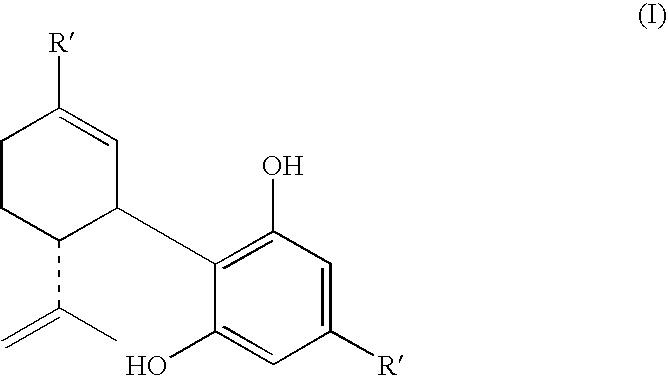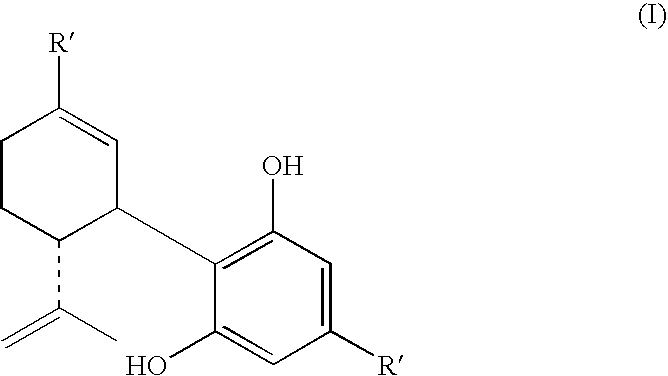Treating or preventing diabetes with cannabidiol
- Summary
- Abstract
- Description
- Claims
- Application Information
AI Technical Summary
Benefits of technology
Problems solved by technology
Method used
Image
Examples
example 1
Preventing Diabetes in NOD Mice by Administering Cannabidiol Materials and Methods
[0101] Animals: Non-obese diabetic (NOD) mice develop spontaneous autoimmune diabetes and are commonly used as an experimental model for human insulin-dependent diabetes mellitus [Miazaki A., Clin. Exp. Immunol. 60:622 (1998); Harada, M., Exp. Clin. Endocrinol. 89: 251 (1987)].
[0102] Six to twelve week old NOD / Ltj female mice were fed standard laboratory animal chow ad libitum and were kept in Specific Pathogen Free (SPF) animal house facility.
[0103] Experimental design: Cannabidiol (CBD) was extracted and purified from Cannabis plant as described by Gaoni and Mechoulam (J. Am. Chem. Soc. 93: 217-224, 1971). The purified CBD was dissolved in a solution of alcohol: chremophor-el:saline at a ratio of 1:1:18 and was administered to mice intraperitoneally at a dose of 5 mg a.i / kg (100 μg per mouse), five i.p. injections per week for a total of 10-23 injections. Mice injected with vehicle alone as well a...
example 2
Cannabidiol Suppressing Diabetes in Male NOD Mice Induced with the Disease
[0114] Animals—see Example 1, above.
[0115] Experimental design—Male NOD mice were irradiated (650 cGy), 24 hrs prior to intravenous injection of spleen cells (25-28×106) derived from female diabetic mice. The injected mice were divided into three groups including untreated control; vehicle-treated mice (20 IP injections, 5 times / week); and CBD treated mice (5 mg / kg CBD, 20 IP injections, 5 times / week).
[0116] Intraperitoneal glucose tolerance tests (IPGTT)—see Example 1 above. Blood glucose levels above 140 mg / dl were considered diabetic by testing blood glucose at t-0, 60 min following IP injection of 1 gr / Kg body weight of glucose [Glucometer Elite apparatus (Bayer Diagnostics, ELKART, Ind.)]. Alternatively, urine samples were taken-twice a week from diabetic mice for testing glucose levels. Urine glucose levels above 1000 mg / dl as determined by combi 9 Teststrips (Medi-Test, Macherey-Nagel, Duren, Germany...
PUM
| Property | Measurement | Unit |
|---|---|---|
| Fraction | aaaaa | aaaaa |
| Fraction | aaaaa | aaaaa |
| Fraction | aaaaa | aaaaa |
Abstract
Description
Claims
Application Information
 Login to View More
Login to View More - R&D
- Intellectual Property
- Life Sciences
- Materials
- Tech Scout
- Unparalleled Data Quality
- Higher Quality Content
- 60% Fewer Hallucinations
Browse by: Latest US Patents, China's latest patents, Technical Efficacy Thesaurus, Application Domain, Technology Topic, Popular Technical Reports.
© 2025 PatSnap. All rights reserved.Legal|Privacy policy|Modern Slavery Act Transparency Statement|Sitemap|About US| Contact US: help@patsnap.com



